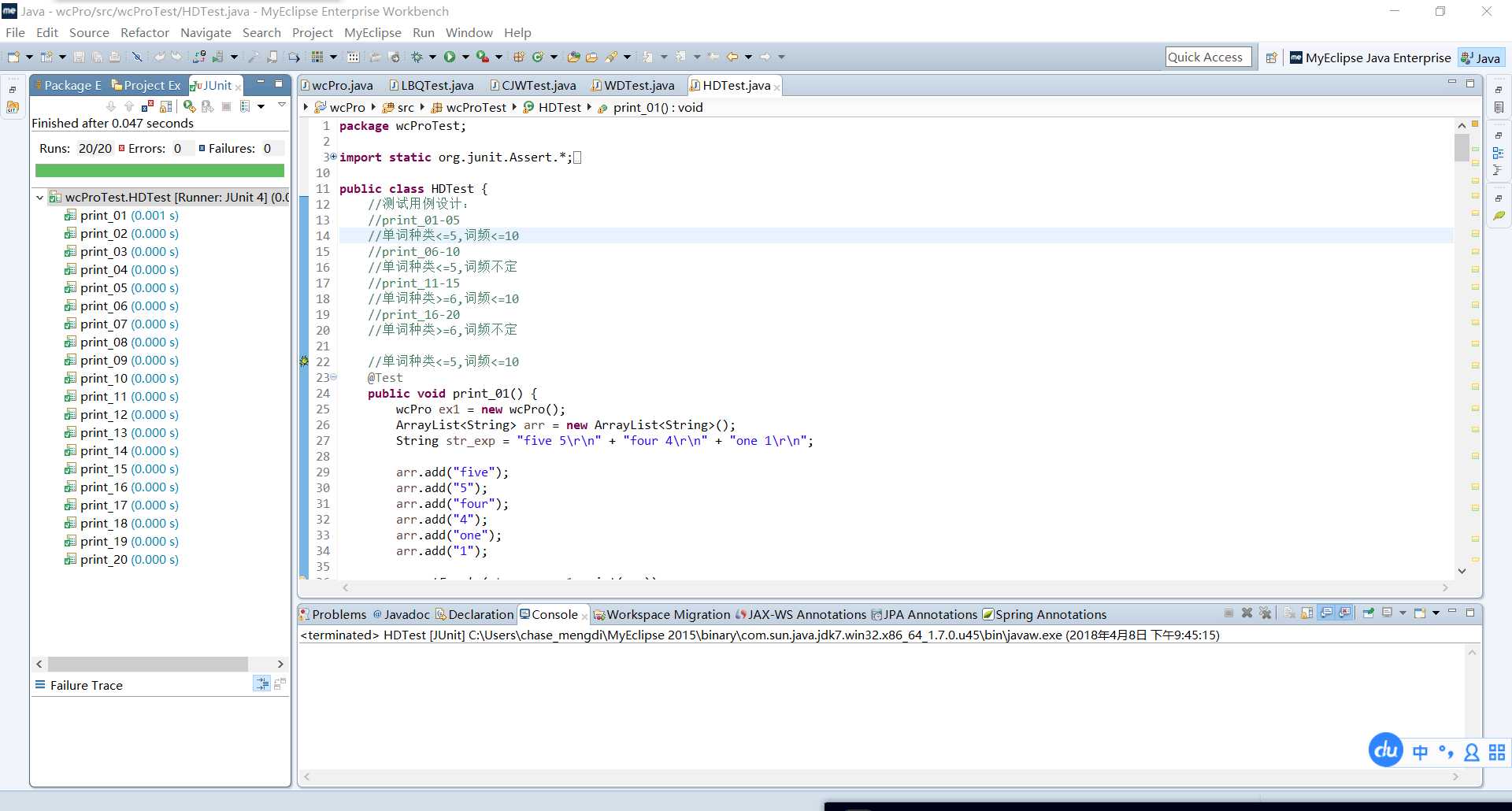标签:步骤 编写 结果 NPU bar gpo 编号 cin static
|
PSP2.1 |
PSP阶段 |
预估耗时(分钟) |
实际耗时(分钟) |
|
Planning |
计划 |
15 |
15 |
|
Estimate |
估计任务需要多少时间 |
25 |
30 |
|
Development |
开发 |
100 |
100 |
|
Analysis |
需求分析 |
20 |
20 |
|
Design Spec |
生成设计文档 |
20 |
15 |
|
Design Review |
设计复审 |
20 |
15 |
|
Coding Standard |
代码规范 |
20 |
15 |
|
Design |
具体设计 |
20 |
25 |
|
Coding |
具体编码 |
60 |
60 |
|
Code Review |
代码复审 |
20 |
30 |
|
Test |
测试 |
60 |
80 |
|
Reporting |
报告 |
80 |
95 |
|
Test Report |
测试报告 |
30 |
50 |
|
Size Measurement |
计算工作量 |
30 |
25 |
|
Postmortem |
总结 |
20 |
20 |
|
|
合计 |
530 |
560 |
我主要负责将排序后的单词和词频输出到文件。代码实现:
public class Output {
public static void output(ArrayList<Entry<String, Integer>> list, File outputFile) throws IOException{
if(outputFile==null){
outputFile=new File("result.txt");
}
//FileWriter fW=new FileWriter(outputFile,true);
FileWriter fW=new FileWriter(outputFile);
BufferedWriter bw=new BufferedWriter(fW);
bw.close();
}
}
测试用例设计:
|
Test Case ID测试用例编号 |
Test Item 测试项(即功能模块或函数) |
Test Case Title 测试用例标题 |
Test Criticality重要级别 |
Pre-condition预置条件 |
Input 输入 |
Procedure 操作步骤 |
Output预期结果 |
Result实际结果 |
Status是否通过 |
Remark备注(在此描述使用的测试方法) |
|
1-5 |
输出控制模块 |
单词种类<=5,词频<=10 |
H |
无 |
wcPro.exe |
无 |
参数数量错误 |
参数数量错误 |
是 |
黑盒测试 |
|
6-10 |
输出控制模块 |
单词种类<=5,词频不定 |
H |
无 |
wcPro.exe -a test.txt |
无 |
参数数量错误 |
参数数量错误 |
是 |
黑盒测试 |
|
11-15 |
输出控制模块 |
单词种类>=6,词频<=10 |
H |
无 |
wcPro.exe -a |
无 |
参数数量错误 |
参数数量错误 |
是 |
黑盒测试 |
|
16-20 |
输出控制模块 |
单词种类>=6,词频不定 |
H |
无 |
wcPro.exe test.c |
无 |
输入格式错误 |
输入格式错误 |
是 |
黑盒测试 |
单元测试运行结果:

小组贡献:因为编程能力不够,只完成了控制输出的部分,贡献率为0.13.
选择刘博谦(17070)的代码进行分析
// 词频排序
public static ArrayList<String> sort(HashMap<String, Integer> map) {
// 以Key进行排序
TreeMap treemap = new TreeMap(map);
// 以value进行排序
ArrayList<Map.Entry<String, Integer>> list = new ArrayList<Map.Entry<String, Integer>>(
treemap.entrySet());
Collections.sort(list, new Comparator<Map.Entry<String, Integer>>() {
public int compare(Map.Entry<String, Integer> o1,
Map.Entry<String, Integer> o2) {
// 降序
return o2.getValue() - o1.getValue();
// 升序 o1.getValue() - o2.getValue())
}
});
ArrayList<String> str = new ArrayList<String>();
int i = 0;
for (Map.Entry<String, Integer> string : list) {
// 排除-与空格
if (!(string.getKey().equals("")) && !(string.getKey().equals("-"))) {
str.add(string.getKey());
str.add(string.getValue().toString());
// 输出前1000个单词
if (i > 1000)
break;
i++;
}
}
return str;
}
刘博谦的代码遵守了《阿里巴巴Java开发手册》第二条的强制规定,代码命名规范,无需改进。
开发规范
阿里巴巴Java开发规范手册
参考资料:
《阿里巴巴JAVA开发手册》
https://wenku.baidu.com/view/87c4d56c7e21af45b307a88d.html
标签:步骤 编写 结果 NPU bar gpo 编号 cin static
原文地址:https://www.cnblogs.com/hddddd/p/8747542.html